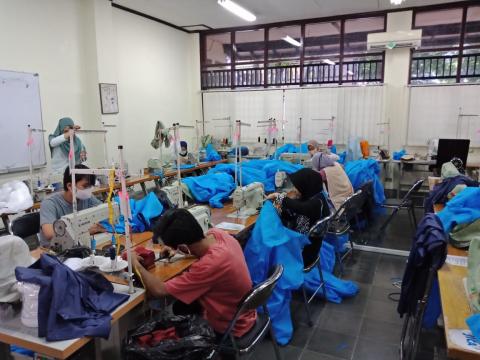Fakultas Teknik Kampus Karangmalang, Yogyakarta, 55281
 Bahasa Indonesia
Bahasa Indonesia English
English

We know that paramedics who are the frontline in the treatment of positive patients Corona Virus Disease 2019 (Covid-19) who struggle with sincerity and fearless are only armed with rudimentary personal protective equipment. Starting from this condition, the Study Program of Fashion Engineering (S1) and Fashion Design (D4) Yogyakarta State University wants to contribute to the efforts of handling Covid-19 by making mass personal protective equipment consisting of hazmat clothes, masks, and face shields (face shield). Adam Jarussalem, Ph.D., as the Head of Department and coordinator of this activity, said that a total of 400 sets of personal protective equipment were produced and would be distributed to a number of health services in 4 districts of Yogyakarta Special Region, namely Sleman, Bantul. Gunung Kidul and Kulon Progo, as well as the Covid Crisis Center (C3) Team at Yogyakarta State University.
"The hazmat shirts we produce consist of 3 types considering the availability of materials, namely parasites, 50 gsm spunbound, and 75 gsm spunbound laminates. We realize that the hazmat clothing produced is not necessarily in accordance with standards because there is no standardized medical test, "Adam said. However, Yogyakarta State University continues to produce this personal protective equipment considering the availability of personal protective equipment for paramedics which is still minimal. The use of personal protective equipment is better than not wearing it at all. This personal protective aid device does not guarantee 100% safe from viruses but is able to guarantee to reduce the amount of exposure from Covid-19. Because of this personal protective equipment is intended for paramedics who do not come into direct contact with Covid-19 patients or if used by paramedics who come in direct contact with positive patients with Covid-19, the hazmat clothes produced by Yogyakarta State University as one of the upholstery clothes which must be coated again with other standard medical protective clothing.
"This step is taken because we see the fact the lack of availability of personal protective equipment makes many officers, especially medical personnel in the area forced to still use makeshift protection," concluded Adam when asked regarding the background of this activity.
While Triyanto, MA., Coordinator of D4 Dress Design Study Program, who was met on the sidelines of the process of making personal protective equipment, said that the production process was carried out almost every day from April 6, 2020 in the garment laboratory and work from home involving 10 students of Clothing who migrated in Yogyakarta and could not go home to hometown so that they can provide positive activities during online learning. Furthermore Triyanto, explained the specifications of personal protective equipment made, namely Hazmat (hazardous materials) which are personal protective equipment consisting of impermeable materials and used for protection against hazardous materials.
There are 3 types of hazmat shirts produced based on the raw material: 1) hazmat shirts made from parasites; 2) hazmat shirts made from spunbound laminate; and 3) spunbound made of harmonic clothing which is expected to be able to hold liquid / droplets.
Fabric masks consisting of 3 layers are intended to optimize the prevention of virus infiltration. The outer layer is made of waterproof fabric so that it can prevent the absorption of droplets emanating from people around / the person you're talking to; The middle layer is made of viselin which is used as a filter / filter on microns that enter the mask and the inner layer is made of antibacterial cloth and face covering (face-shield) that serves to cover the face of the droplet of people around / interlocutors.
Fakultas Teknik Kampus Karangmalang, Yogyakarta, 55281
Copyright © 2025,
